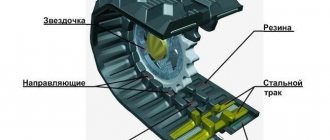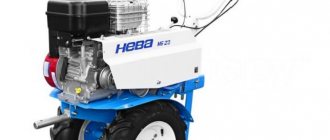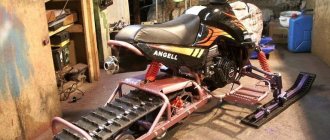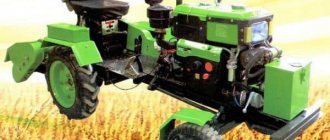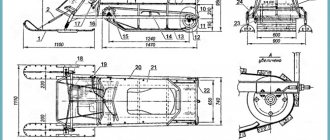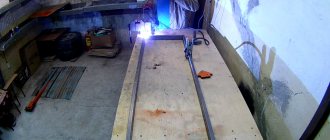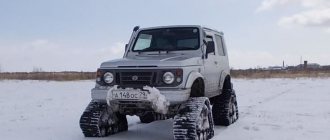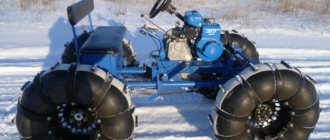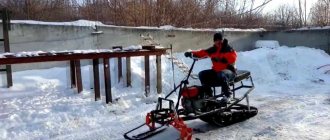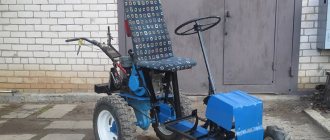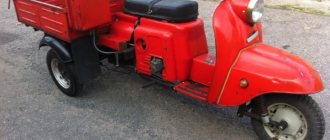Owners of walk-behind tractors are increasingly resorting to all sorts of home-made production of various components for this unit.
As a result, we get do-it-yourself attachments, transforming the walk-behind tractor into a more powerful one by installing a new engine, as well as many different modifications and additions.
Of course, all this is not due to a good life, because most owners of a walk-behind tractor strive not only to save on its purchase, but also to reduce the costs of its further operation.
In particular, many want to make homemade tracks for walk-behind tractors, thereby wanting to improve the cross-country ability of their units.
The resulting walk-behind tractor on tracks will perform a slightly different role in a person’s personal household, because it is already becoming a full-fledged vehicle, somewhat reminiscent of a caterpillar tractor.
Accordingly, a much wider scope of work opens up before him, which largely justifies this kind of independent alteration.
About the device
Tracked walk-behind tractors are much less common than their wheeled counterparts. The explanation for this is quite clear - wheeled walk-behind tractors Cayman, Patriot, Texas, Foreman, Crosser, Viking, Forza are more suitable for plowing land, i.e. its design is most suitable for working on the ground.
Thus, all conversions of a wheeled walk-behind tractor into a tracked walk-behind tractor involve the additional attachment of one wheel on each side. As a result, we get a 4-wheeled walk-behind tractor, on which you can already put on tracks (homemade or store-bought, for example, Buran caterpillar).
Additional wheels
By the way, additional wheels can be made removable so that you can quickly turn it back into a standard walk-behind tractor for working in the garden. This can be achieved by attaching these wheels to an axle that we already have in stock, through a flexible or rigid transmission.
This solution is the most appropriate, because there is no need to weld additional fasteners.
As for the design of such walk-behind tractors, they are completely identical to wheeled walk-behind tractors:
- Engine. Tracked models use a more powerful 4-stroke engine, which has an axle locking function.
This is important because it allows the crawler to turn in place without making a full circle to turn.
- Transmission. Gearbox, gearbox and clutch system - this standard set is also included in the design of tracked walk-behind tractors.
- Chassis. Here, in principle, everything is clear from the name - the design uses tracks instead of a wheelbase. As already mentioned, in the case of alteration, one roll is added to the existing pair of wheels on each side, on which a homemade caterpillar is already put on.
- Controls. They are located on the control handle, including various clutch levers, emergency engine stop, etc.
Before we begin to describe the method of making tracks yourself, it would not hurt to evaluate the offer of some special stores that sell walk-behind tractors and related materials. In particular, we will estimate the cost of some types of tracks for well-known walk-behind tractors.
Caterpillars for the Neva walk-behind tractor
Snowmobile attachments for the Neva walk-behind tractor
Thus, the tracks for the Neva walk-behind tractor, the price of which is about 28 thousand rubles, is a full-fledged snowmobile attachment. Seats for drivers can be purchased separately, thanks to which the Neva walk-behind tractor becomes similar to a mini tracked tractor, albeit with lower performance indicators.
Technical data:
- developed speed (with Neva walk-behind tractor) – about 18 km/h;
- total weight of the console – 37 kg;
- length – 100 cm;
- width – 60 cm;
- height – 34 cm;
- number of passengers – one driver and one passenger.
For more information about the caterpillar drive for the Neva walk-behind tractor, watch the video:
In addition, an attachment to a walk-behind tractor on tracks is available for sale, designed for attachment to the Agat and Salyut models. Its cost is 25-27 thousand rubles. This design does not have the ability to attach a driver's seat, which somewhat limits the capabilities of this device.
However, it is quite suitable for off-road and snowy driving. Snowmobile attachments on tracks for walk-behind tractors are quite common, as evidenced by a fairly large number of different models in online stores.
Their distinctive feature is the ability to control them not only with two hands, following the walk-behind tractor, but also while sitting in a folding sled, which, however, must be purchased separately.
Considering that the average price for such attachments is about 30 thousand rubles (plus the price of folding sleds is about 5 thousand rubles), we can say that making tracks yourself is a fairly optimal solution for those who do not have the opportunity to spend extra money on purchasing .
Top popular walk-behind tractor models on tracks
Tracked walk-behind tractors are a rarity; in most cases, manufacturers produce gooseneck attachments that can be installed on wheeled models. Most often, there are specialized snow-removing walk-behind tractors on tracks.
- Caiman Vario is one of the most famous crawler walk-behind tractors. The machine consists of a standard walk-behind tractor on Caiman Vario 70S pneumatic wheels with a Japanese 7 hp engine, removable tracks and a two-seater sled. In this winter configuration, it can be used as a snowmobile for fishing or hunting trips. For work related to the transportation of goods over rough terrain, the walk-behind tractor is equipped with cargo sleds and weights. To remove snow, you can install a shovel blade or a snow removal attachment.
- Yard-Man YM 7110 DET – snow plow walk-behind tractor with a 10 hp 4-stroke engine. Working width – 710 mm, working height – 530 mm, snow throw range – up to 15 m. 8-speed drive (6 forward, 2 reverse) with friction clutch and tracks with directional tread guarantee high performance even in difficult areas.
- HUTER 8100C is a self-propelled snow blower equipped with a four-stroke single-cylinder 11 hp engine, designed for effective clearing of snow drifts in emergency winter conditions. The snow blower's chute covers a snowdrift of 700 mm in width and 540 mm in height. The power plant of the unit is equipped with an electric starter, heated handles and an autonomous fuel supply.
Do you use a crawler walk-behind tractor for snow removal, cross-country driving, winter fishing or hunting?
Necessary materials
As mentioned earlier, to transform the wheeled walk-behind tractors Sadko, Don, Huter, Profi, Plowman, Champion, Carver, Husqvarna into a tracked walk-behind tractor, you will need a fairly powerful engine with axial locking.
Power is important because such a walk-behind tractor will be used on a fairly complex surface, the maneuverability of which requires additional technical data.
Track materials
To summarize a little, we can highlight the main materials that we will need:
- The presence of the walk-behind tractor itself with a gearbox with a powerful 4-stroke engine with axle locking.
- A couple of extra wheels so you can pull the track on them.
- The homemade caterpillar itself, made from available materials.
- Depending on what material will be used in production, we may need two large car tires or transport tape.
Using these materials, you can make a fully functional crawler walk-behind tractor.
At the same time, you can make a full-fledged mini tractor on tracks if you add an additional cargo platform, or use it as an all-terrain vehicle in the snow by adding a platform on skids. In general, there is complete scope for imagination.
Tracked platform, types, modifications
This equipment is produced by both domestic companies and foreign manufacturers. As a result of this, there are many modifications that differ:
- according to form;
- according to the installation principle;
- by use.
Module forms
From the variety of models, two main forms can be distinguished:
- Rectangular axial;
- Triangular gear.
Axial attachments consist of:
- platforms;
- axles;
- four rollers;
- two gears;
- two caterpillars.
The platform is attached to the walk-behind tractor with bolted connections. Four rollers are attached to the bottom of the axle. The rollers create the necessary tension on the track. Two gears located on both sides of the track, falling into the groove, set the platform in motion.
The triangular gear attachment consists of the following elements (for each track separately):
- big gear;
- rigid frame;
- eight rollers;
- caterpillar belt.
Triangular track drive
Large gears are mounted on an axis coming from the walk-behind tractor gearbox. The rollers are fixed in the lower part of the rigid frame; they are located in pairs on both edges of the caterpillar track. This structure allows for the necessary tension of the track when moving. Unlocking the differential allows the walk-behind tractor to perform various maneuvers - turns, turns, etc.
This is important to know!
When deciding to buy (or make your own) a crawler drive for a walk-behind tractor, you need to take into account the following characteristics of the attachment:
- The optimal speed of movement of a walk-behind tractor on caterpillar tracks. Powerful models can provide speeds from 18 to 20 km/h.
- Load capacity of attachment. In most cases, models with a carrying capacity of 200 kg are purchased, but each owner of the equipment has the right to choose and select this characteristic to suit his needs, taking into account the engine power of the walk-behind tractor.
- The maximum permissible height of snow masses (if you plan to use the attachment and walk-behind tractor as a snowmobile). The main limiter is the engine height. Modern attachments allow you to comfortably move through snow up to 50 cm high.
- The permissible level of liquid dirt and water also ranges from 45 to 50 cm. The reason is the same - the height of the engine.
In order to ensure long service life and serviceability of all module elements, it is necessary to regularly (before and after each operation) perform the following actions:
- Inspect the track attachment before driving.
- Check the tension of the rollers.
- Check the reliability of fasteners.
- Pay attention to the integrity of the tracks and the condition of the caterpillar tracks.
- Regularly lubricate all moving components and parts of the track structure.
Step-by-step instruction
Many people ask the question - how to make tracks on a walk-behind tractor with your own hands? To answer this question, let's look at several effective ways to make tracks yourself, proven in practice.
From a transport tape to increase the cross-country ability of an all-terrain vehicle
One of the simplest methods is to make a caterpillar from a transport belt using a bushing-roller chain. The ease lies in the fact that to make them you do not need to use a large number of tools and aids.
Transport tape
To extend the service life of our transport tape in the device of a caterpillar walk-behind tractor, you can sew it along the edges with fishing line, observing a step of 10 mm. To connect the tape into the ring we need, you can stitch it along the ends, or use a hinge.
Particular attention should be paid to the thickness of the transport belt, because it directly depends on the degree of load on the unit. The optimal choice would be a tape with a thickness of at least 7 mm. In addition, we need to take care of an additional wheel on each side.
You can take it from an old car, but remember that the diameter must be identical to the wheel on the walk-behind tractor.
Tracked module made from a tire
Caterpillars made from tires for walk-behind tractors are also a fairly common homemade product, characterized by a highly reliable design. However, in order for the resulting crawler walk-behind tractor to be practical, you need to take care of finding the right car tires.
Farm owners are increasingly resorting to the purchase of special technical devices - grain crushers, with the help of which they can process raw materials, thus preparing food feed on their own. By clicking on the link, you will learn how to make a grain crusher from a washing machine with your own hands.
On the domestic market of agricultural machinery there are various options for cultivators, not only Russian, but also foreign-made. The Mantis cultivator is a reliable and practical technique that will last for decades.
Recently, small-sized agricultural machinery has become very popular, allowing them to do the same work as their “big brothers”, but at the same time they cost an order of magnitude less. Here's everything about the different types and characteristics of mini grain harvesters.
In particular, they must have the necessary tread pattern, preferably from tractors or large machines. The tread pattern is very important because it acts as a lug and also increases the track's grip on the surface.
Car tires
Let's divide the manufacturing process into several steps:
- Having found suitable tires, we need to cut out a track for the tracks. This is quite a labor-intensive job that will take a lot of time.
- For cutting, you can use a well-sharpened shoe knife, which should be soaked in a soapy solution from time to time - this will help cut the rubber better.
- You also need to cut both sidewalls off the tires. To simplify the process, the sidewall can be cut using an electric jigsaw with fine teeth.
- If necessary, remove excess parts from inside the tire. This manipulation must be performed if the track is too hard from the inside.
The advantage of this method is that there is no need to connect it into a ring, because the tire already has a closed structure. This increases the reliability of such tracks, which is quite important under heavy load conditions.
However, such tracks are obtained in a rather limited length - exactly the length of a car tire.
How to make a homemade caterpillar from belts and chains
All-terrain vehicles on tracks from a walk-behind tractor can be made using the most ordinary belts with a wedge-shaped profile. The belts are connected to each other by means of a lug, attached to the belts using rivets or screws.
Another way is to make a track from chains of the same size. Many summer residents have similar material in bulk in their garages, which simplifies the search process. The entire manufacturing process comes down to the following points:
- Take two chains of the same size.
- The last links of these chains must be opened and then connected into a closed ring.
- Next, we clamp the links and weld them.
The chains are fastened to each other using lugs, which can be made from ordinary steel plates of the required thickness. They are connected to the chain using bolts.
Scheme
Motoblock on Buran tracks
If you do not want to make tracks yourself, then you can borrow them from old equipment. For example, a walk-behind tractor on Buran tracks performs quite well.
It is advisable to use the old part, because a new Buranovskaya caterpillar will be quite expensive, and the goal of such alterations is to maximize cost savings.
The principle of movement of caterpillar vehicles
For a tracked vehicle of any purpose, be it a tank or a snowmobile, forward motion is provided by a tracked propulsion unit (CT).
It uses two motivating factors:
- torque Mk transmitted from the engine/power drive to the drive wheels;
- adhesion of tracks to the ground.
A caterpillar or caterpillar chain of a main engine is a link structure, which is a continuous continuous belt or chain.
For full traction with the ground surface, the caterpillar is equipped with raised protrusions that serve as active lugs.
The caterpillar principle is illustrated by the kinematic diagram of the main engine operation located below. The following positions are indicated on the diagram:
- pos. 1 – caterpillar;
- pos. 2 – support rollers that prevent the track belt from sagging;
- pos. 3 – drive sprocket (drive wheel), which converts torque from the engine into traction force necessary for the forward movement of the machine;
- pos. 4 – support rollers, ensuring full contact of the track belt with the surface of the ground support;
- pos. 5 – shock absorbers;
- pos. 6 – guide wheel, which serves to direct the forward movement of the machine and transfers part of its weight to the ground.
Movement according to the caterpillar principle is carried out as follows:
- Torque Mk is supplied to the drive sprocket (item 3).
- The rotating sprocket rewinds the continuous track belt/chain (item 2).
- The caterpillar (item 2) is in close adhesion to the support surface (soil, loose soil, etc.). It is affected by:
- force Rz – reaction of the supporting surface that the caterpillar transmits to the vehicle frame;
- weight load G;
- tangential reaction of the ground support Pk.
The rewindable track belt/chain is continuously laid in the direction of forward motion of the vehicle on the surface of the ground support under the road wheels, creating a path for the vehicle wheels with lower resistance to movement than on soft ground.
During movement, the caterpillar belt rises from the supporting surface and transfers the pushing force to the vehicle frame.
The specific pressure on the support (soil) along the length of the track is uneven - increased in the area of the drive sprockets, decreased in the front part in the area of the guide wheel (item 6). The maximum pressure on the ground from the main engine is in the area of the road wheels (item 4).
Additional tips and warnings for making your own goose
Before you start making a homemade caterpillar, you need to clearly understand its necessary parameters. The fact is that if a very high caterpillar is manufactured, the center of gravity of the walk-behind tractor itself will be changed, which will inevitably lead to certain problems when turning, i.e. the unit will fall on its side.
To avoid this, the second driven axis needs to be increased by a few centimeters. You can also slightly expand the wheelbase of your existing walk-behind tractor. To do this, you can purchase a bushing in a special store, and then install it on the drive shaft.
Walk-behind tractor engine
In addition to the engine power requirements, it is worth paying attention to its cooling system. The fact is that air cooling does not cope very well under high loads, which leads to significant overheating of the motor.
Thus, it is better to give preference to a water-cooled engine, which shows more stable performance.
Structural differences
The tracks for the Neva walk-behind tractor greatly simplify the transportation of cargo and the movement of the equipment itself. The tracked module covers a significant surface, the walk-behind tractor drives more smoothly, provides the least pressure on the road and does not slip on difficult soils. The tracked vehicle can operate even in bad weather, and in sunny weather it has excellent maneuverability.
It is not difficult to care for and use the module on tracks, and you can build it yourself. The main thing to understand is that when a walk-behind tractor is equipped with tracks, its speed limit will be lower, but not significantly.
Note! The ability of equipment to move through difficult soils, transport significant weights, and even clear roads of snow is increasing.
In other respects, walk-behind walk-behind tractors are absolutely no different from standard walk-behind tractors:
- The engine is a 4-stroke engine with the ability to automatically lock the axis so that the technical device can turn around without turning around in a circle.
- There is also a requirement for mandatory water cooling, which can cope with overloads due to which the engine heats up excessively.
- This type of tracked module is more efficient than an air-cooled one.
- The coupling system, gearbox and gearbox are similar to the design of the standard model. It must be controlled by using the handle.
When making tracks for a walk-behind tractor with your own hands, you need to know that if you design them very high, the center of gravity of the walk-behind tractor will change, and it will begin to have problems when turning, and even bending sideways. It is necessary to make the second driven axle longer by 2 cm. Also, by using a bushing, it will be possible to expand the wheel base that is already available in the walk-behind design.
From toothed conveyor belt
This method is the simplest, and therefore the most common. It does not require special knowledge and skills, as well as many tools and materials.
- First you need to determine the desired length of the tape. (It is defined as the circumference of one wheel + the distance between the axles of each pair of wheels multiplied by 2).
- Next, you need to make the future caterpillar strong and reliable. To do this, the tape must be swept along the edges with fishing line and ties, in increments of about 10 mm.
- To form a ring, it is better to use a hinge joint (as it is stronger and more durable) or simply sew the tape along the ends.
- Install the resulting caterpillar tracks onto the cultivator wheels.
Other equipment equipped with tracks instead of wheels
If you look at it, you can put any equipment on tracks, regardless of its purpose. And if previously only garage craftsmen, of whom there are a great many in Russia, were engaged in such “experiments”, today you can see similar factory-produced equipment.
Not only snowmobiles and swamp vehicles are equipped with tracks, but also mini-tractors, which were not originally intended for these purposes. But production vehicles mounted on caterpillar tracks are of particular interest.
Tracked vehicle: buy or make it yourself
If we think from the point of view of economy, then making tracks for a car yourself is more acceptable. However, in this case, you should be prepared for the fact that you will have to frequently repair it in the field. But there are also advantages - several breakdowns, and the garage technician knows all the weak points, after which he strengthens them.
The factory version is more expensive. But here you can rely on the tests carried out. Although, as practice shows, even such tracked units break at the most inopportune moment. We invite you to watch a video in which a Niva is installed on tracks (though not with your own hands, but in a factory setting).
Watch this video on YouTube
DIY snowmobile tracks
A snowmobile a priori must be equipped with tracks - without this it will not be able to move. However, the problem is that they can fail.
In this case, there are 3 options for the development of events.
- If you have time and desire, it is quite possible to use a conveyor belt as a homemade track for a snowmobile. The main thing is to firmly sew the ends and strengthen the sides so as not to remain in some snowdrift away from people when the connections are broken. In winter forest conditions, repairing a snowmobile track with your own hands, although possible, is problematic.
- Contact craftsmen, who can always be found in garage cooperatives.
- Purchase new tracks from a specialty store. This option is good, but it can make a hole in the family budget.
Homemade mini-tractor on tracks: what to make with your own hands
The best mini-tractor can be called a modernization of a walk-behind tractor. If the owner does not want to install it on a crawler track himself or simply does not have time for this, it is quite possible to purchase the necessary components.
And after the tracks for the Neva walk-behind tractor or any other have been purchased, you can attach various attachments to it (plow, hiller, flat cutters). Prices for small tracks for walk-behind tractors are not too high, unlike long elements used in larger equipment.
Homemade all-terrain vehicle with caterpillar tracks: do-it-yourself swamp vehicle
All-terrain swamp vehicles are a completely different story. For many hunters and fishermen, making an all-terrain vehicle from a walk-behind tractor (Neva or any other) today remains the only option. Not everyone can afford the purchase of such equipment. In addition, it is easier to repair a home-made unit on the road if you assemble it yourself, piece by piece.
From belts and chains
Another method of making a track involves using standard V-belts and chains.
- To make a caterpillar from the belts, they must be connected to each other by lugs (tracks) using bolts or rivets.
- To create a goose from chains, you need to take two pieces of chain of the same length. Unclench the end links of both segments and connect the chains so that you get two closed rings. Next, the loosened links are clamped and welded for strength.
You can watch the video on how to make tracks for a walk-behind tractor with your own hands:
Next, metal lugs (tracks) of the required thickness are manufactured. Instead of steel, you can use another material (wood, plastic, etc.). The tracks are bolted or welded to closed chain links to form a track.
Recommendations for use
When using walk-behind tractor tracks, you must constantly check how well the chain is tensioned, and also regularly oil the parts whose friction occurs during movement. In addition, it is recommended to check each time before use whether any damage or breaks have appeared on the circuit. After the trip, you should also conduct a routine inspection in order to detect any damage or failed hooks in time. When using a walk-behind tractor, you should avoid hitting roots and rocks, as well as stumps, otherwise the tracked module will very quickly be torn.
For a review of the all-terrain walk-behind tractor on tracks, see the following video.
3 MORE REASONS FOR MUTUALLY BENEFICIAL COOPERATION WITH US
We do not place orders externally with a subcontractor, but directly carry out all stages ourselves
This is one of the main reasons for the low cost of the product.
Our entire production cycle takes place in one place; there is no need to move a part from production to production.
On the one hand, it is close to Moscow, next to the logistics center of the country, on the other hand, the proximity of production, warehouses from the terminals of transport companies, in the immediate vicinity of 1 km.
Owner reviews
Ruslan, 40 years old:
I have a homemade attachment, I made the tracks from old truck tires, installed an additional set of wheels and tensioned the “caterpillar”. The result is an interesting design that provides excellent cross-country ability both in swampy areas and on snow. I can move around the village this way without any problems, no slipping, and I can take an additional rider. I'm happy with my work.
Sergey, 44 years old:
I have been using the Skif walk-behind tractor for four years now. Over the last two years, I bought an SP-MB-F attachment for it, which greatly improved the performance of the walk-behind tractor, eliminating the discomfort during the rainy spring and autumn. This winter I decided to use caterpillar tracks to clear snow - the wheel drive is much inferior to caterpillars.
Oleg, 29 years old:
I am an avid fisherman in my life, so in my free time I try to do what I love. I live in the suburbs, and, naturally, I have a walk-behind tractor for farming. At first I used it that way... Then I accidentally found out on a forum that a walk-behind tractor with a caterpillar can be an excellent vehicle both in winter and off-road. I decided, took a closer look and bought the SP-MB-SP-PN console for my Patriot. The result exceeded expectations!
Specifications
We produce track drives in our own production facility in Vologda, paying special attention to quality and practicality. The drive is suitable for walk-behind tractors: “Salyut”, “Caiman”, “Cascade”, “OKA”, “NEVA”, “AGAT”, “Kadvi”, “UGRA”. Suitable for walk-behind tractors with a 25/30 mm round or 23/32 mm hexagonal gear shaft.
- Simplicity of design
- Ease of use
- High ground clearance
- High quality workmanship
- Installation as simple as possible
- Large surface support area
- Possibility of changing the “track”
- Minimum load on the gearbox due to low unsprung mass
Description
Starting the review of tracked modules for walk-behind tractors, I would like to say that these attachments have proven themselves not only when carrying out agricultural work. The modules are no less relevant in winter, when making your way through snowy areas is quite problematic.
A walk-behind tractor with a caterpillar drive can be used year-round; its operation is relevant when:
- carrying out field work on heavy or marshy soils;
- clearing areas of snow complete with a snow removal attachment;
- transportation of goods over difficult terrain;
- and also as a vehicle for winter fishing or hunting.
The main advantage of tracked vehicles is as follows:
- better traction with the soil, which means better cross-country ability;
- greater stability of the unit due to more uniform weight distribution;
- the ability to work with a variety of attachments;
- quick transformation from wheel drive to track drive and vice versa.
We invite you to watch a video about crawler walk-behind tractors:
